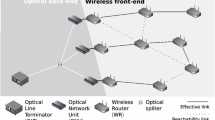Abstract
Radio over Fiber is the integration of the wireless communication over the Fiber system is the next generation communication region. The effect of the four wave mixing plays an important role while transferring the data in the Fiber systems. The system introduces more adherable results during the data transmissions in Radio over Fiber Systems. Hence we propose the new optimization algorithm so called Cognitive Optimization algorithms which can be integrated to overcome the effects of above mentioned. The cognitive optimization is the new algorithm which deals with the adoption of modulations techniques which can be adaptive as the distance of the implementation increases. We have implemented with the different modulations and compared with the our algorithms to prove that the adoption of our algorithms finds its suitable when the Radio over Fiber is can be extended to the 4G networks and also it has been tested with the LTE-A signals.














Similar content being viewed by others
References
Flavio, C. (2016). Cruz optical frequency combs generated by four wave mixing in optical fibers for astrophysical spectrometer calibration and metrology. IEEE Transactions on Magnetics, 52, 1–18.
Sabapathi, T., & Sundaravadivelu, S. (2010). Analysis of bottlenecks in DWDM fiber optic communication system. Optik, 122, 1453–1457.
Singh, A., Sharma, A. K., & Kamal, T. S. (2008). Investigation on modified FWM suppression methods in DWDM optical communication system. Optics Communications, 282, 392–395.
Marcuse, D., Chraplyvy, A. R., & Tkach, R. W. (1991). Effect of fiber nonlinearity on long-distance transmission. Journal of Lightwave Technology, 9, 121–128.
Lichtman, E. (1991). Bit rate-distance product limitations due to fiber nonlinearities in multichannel coherent optical communication systems. Electronics Letters, 27, 757–759.
Agrawal, G. P. (2001). Nonlinear fiber optics and communication systems (Vol. 7, pp. 1–18). New York: Academic.
Chraplyvy, A. R. (1990). Limitations on lightwave communications imposed by optical-fiber nonlinearities. Journal of Lightwave Technology, 8, 1548–1557.
Souza, J. R., & Harboe, P. B. (2011). FWM: effect of channel allocation with constant bandwidth and ultra-fine grids in DWDM systems. IEEE Latin America Transactions, 9, 1–20.
Goloubkoff, M. (1997). Outdoor and indoor applications for broadband local loop with fiber supported mm-wave radio systems. In IEEE Transactions on Magnetics (Vol. 8, pp. 31–34).
Roussell, H., Regan, M., Prince, J., Cox, C., Chen, J., Burns et al. (2007). Gain, noise figure, and bandwidth-limited dynamic range of a low-biased external modulation link. In Proceedings of IEEE International Topical Meeting Microwave Photonics (Vol. 7, pp. 84–87). Canada: Victoria.
Ackerman, E., Betts, G., Burns, W., Campbell, J., Cox, C., Duan, N. et al. (2007). Signal-to-noise performance of two analog photonic links using different noise reduction techniques. In IEEE MTT-S International Microwave Symposium Digest (Vol. 9, pp. 51–54). Honolulu, HI.
Shibata, N., Braun, R. P., & Waarts, R. G. (1987). Phase-mismatch dependence of efficiency of wave generation through four-wave mixing in a single-mode optical fiber. IEEE Journal of Quantum Electronics, 23, 1205–1210.
Agrawal, G. P. (2001). Fiber-optic communication system (Vol. 9, pp. 125–145). New York: McGraw-Hill.
Ablowitz, M. J., & Biondini, G. (1997). Four wave mixing wavelength division multiplexed soliton systems: Ideal fibers. Journal of Optical Society of America, 14(7), 1788–1794.
Koonen, A. M. J., & Larrode, M. G. (2008). Perspectives of radio over fiber technologies. Journal of Optical Fiber Communication (OSA), 6, 345–353.
Bahrami, A. (2008). Performance evaluation of radio over fiber systems using Mach-Zehnder modulator. IEEE Journal on Selected Areas in Communications, 9, 25–39.
Author information
Authors and Affiliations
Corresponding author
Rights and permissions
About this article
Cite this article
Sugumaran, S., Arulmozhivarman, P. A Novel Cognitive Optimization for the Eradication of Non-linear Effects by FWM in Radio-Over Fiber Systems. Wireless Pers Commun 102, 3225–3237 (2018). https://doi.org/10.1007/s11277-018-5364-7
Published:
Issue Date:
DOI: https://doi.org/10.1007/s11277-018-5364-7



